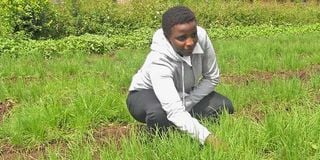Premium
How to scout in onion production

A farmer inspects her onion crop. Farmers need to scout to ensure their plants are getting adequate water. Conduct a simple moisture test by pressing soil on the palm.
In our previous article, we looked at thrips as a pest affecting onions during production. We discuss scouting today.
Scouting is the identification, monitoring or recording of pests, diseases, weeds, water and nutritional needs. It entails inspecting the entire plant, from the roots and soil to new shoots. Desmond is scouting for pests and diseases.
He wants to identify them early and increase the efficiency of prevention and control while lowering production costs.
Scouting is crucial when growing crops as it enables farmers to monitor and assess the health of their plants and spot potential problems. One then takes the necessary precautions to increase yields.
Farmers scouting their fields regularly can detect disease, pest or weather-related damage and nutrient deficiencies early, allowing them to take action.
Scouting assists farmers to make informed decisions regarding pest control, irrigation and fertiliser application, resulting in more effective use of resources.
Overall, scouting is essential to ensuring crop production is successful and profitable.
The growth stage, weather conditions, local pest pressure and other factors determine the scouting frequency.
During the growing season, it is recommended to scout crops at least once a week, but more frequently during periods of rapid growth or when there is a high risk of pest or disease outbreaks.
Frequent scouting
Some crops may necessitate more frequent scouting during particular growth stages, such as flowering or fruiting. Because the ultimate goal of scouting is to detect problems early and take action, frequency should be sufficient to accomplish this goal.
Scouting schedules may need to be adjusted, based on local conditions and experience.
The use of a magnifying lens during scouting ensures a closer and better look at the plant’s health.
Different methods can be used in scouting, such as zigzag, random and indicator crops.
The farmer should select a specific point or scouting position in every method selected.
After scouting, one should determine the distribution of the issues encountered, enabling one to decide on action to be taken.
Keep records indicating the exact location of a problem, its frequency and the control measures. Records help improve the effectiveness of future scouting. In Desmond’s case, the random method will be used.
We’ll use this method to identify the scouting points representing the entire block. This can be used as a scouting position throughout the growing season.
While scouting for pests and diseases, examine the upper and lower parts of the leaves.
Some deficiency symptoms appear on the lower sides of the plant, such as magnesium and nitrogen. Scouting is preferably done early in the morning or late in the evening.
One should also scout to ensure the plants are receiving adequate water.
Conduct a simple moisture test by pressing soil on the palm.
If the soil is sticky and easily forms a ball, one may not need to water the onion crop.
After scouting, Desmond will know the next course of action and plan for the labour on the farm.
In our next article, we shall look at the nutritional requirements of onions.





